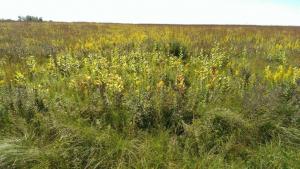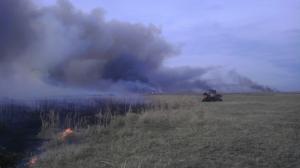The purpose of this sheet is to provide landowners with useful information on how to convert a cool-season introduced grass field into a native prairie field (native grasses and forbs).
Please remember to read and follow herbicide label instructions. For specific recommendations not covered by the label, contact your distributor or manufacturer representative. Please consult with your local USDA Service Center for a more in depth look at your site’s specific restoration needs and eligibility.
Preparation Steps
Consult your local conservation office for appropriate dates to start site preparation if your land is currently enrolled in a program.
Site preparation for a field of introduced grasses may require a full year. Do not rush the site preparation steps. It is important to clean equipment off before and after entering the area to be interseeded to prevent the spread of undesirable species.
- Spray site with glyphosate as early as possible after green up
- If using other herbicides, ensure there is no long-lasting residual
- Wait at least a week after spraying, conduct a prescribed burn to remove vegetation and thatch layer
- Till in spring after green up
- Follow with a disking, generally 2-3 passes
Or
- Till in the spring after green up to break up the sod, generally 2-4 passes
- Brillion pulverizer (packer) or roll site with 50% overlap at a speed <5 mph
- The result should be a smooth, firm seedbed. Your footprint should sink <1 inch
- Spray site again with glyphosate if delaying planting
- Seed site as early as possible and no later than June 30th
- Spray site with glyphosate within 5-7 days after planting
Avoid excessive mowing and only spot spray as needed. Native plantings take 3-4 years to establish and may take up to 5-6 years to establish depending on environmental factors.
Site Preparation using Cover Crops
Sites with fertile, wet, heavy soils and/or with a composition of quackgrass 20% or greater
Planting a cover crop will give you an additional year of tillage and herbicide treatment to provide better control of smooth brome, reed canary grass, and quackgrass. If you plant a cover crop, consult with your local USDA Service Center to develop a cover crop seed mixture. Avoid species like alfalfa and wheat.
- Spray the site with glyphosate before planting the cover crop
- Terminate the cover crop with glyphosate in August prior to tilling
- Follow the steps of either a dormant or spring seeding



